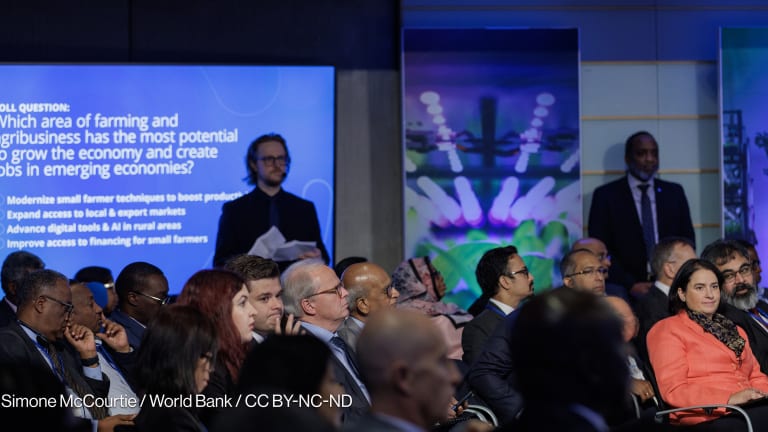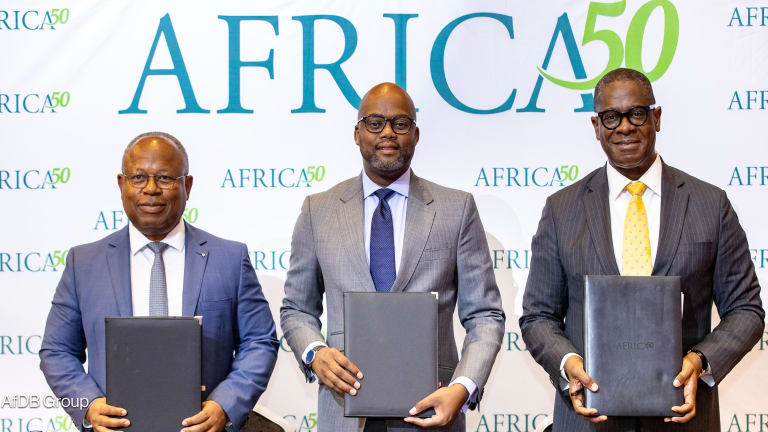Inside AfDB's 'big play' on agriculture processing
The African Development Bank is investing millions of dollars in a plan to turn rural African areas into agricultural powerhouses like the American Midwest. Will it work?
ABIDJAN — Despite Africa’s massive potential for agricultural production, a growing percentage of processed foods consumed across the continent is imported. Working to reverse this trend, the African Development Bank launched a project in 2017 to increase the number of processing facilities in rural Africa. It’s one of the banks “big plays” on agriculture, Jennifer Blanke, vice-president of agriculture, human, and social development at the bank, told Devex. The “Special Agro-Industrial Processing Zones” initiative aims to provide African governments with funding to build up infrastructure in highly productive agricultural areas, to encourage the private sector to build processing facilities there. The bank hopes this will cut back imports and create jobs to entice unemployed youth living in cities back to rural areas. The initiative is part of the bank's Feed Africa strategy. “If you go to the Midwest in the United States, it’s a very attractive place for a lot of people to live. Why should these areas in Africa be any different than Des Moines, Iowa?” --— Jennifer Blanke, vice-president of agriculture, human, and social development, AfDB Each special zone will require an average of over $100 million in both public and private investment. The bank expects that for every $1 in public investment, another $3 worth of private investment will be leveraged. That's what is needed for the processing zones to function optimally, said Olagoke Oladapo, manager of the bank's Rural Infrastructure Development Division. "The whole approach is actually about de-risking private investments in the agricultural value chains by encouraging public investments in critical hard and soft infrastructure, including policy and regulatory frameworks,” he said. “The bank draws on success factors where this approach has worked before, then incorporates these factors into the design of the projects.” But the initiative’s success is far from guaranteed, with observers pointing to challenges including the overinvolvement of governments in the market. “Infrastructure will activate production and open up productive areas. It will also encourage investment,” explained Professor Njuguna Ndung’u, executive director at the African Economic Research Consortium and former governor of the Central Bank of Kenya. “But these zones will only be effective if governments sink back and become only a regulator, not a participant in the market.” A grand plan Africa spent $64.5 billion on importing food in 2017, according to the bank. Much of this can be attributed to a rising middle class, urbanization, and a demand for higher-quality food, Blanke said. “Africans are often buying food from abroad. What that means is that they are exporting jobs,” she said. Through its initiative, AfDB is working with countries to build up the necessary infrastructure in rural areas, in hopes of reversing this trend. “The reason that you don’t get private sector investment to those areas [is] because you don’t have the public sector investment [in] the infrastructure that you need,” she said, adding that the investment in infrastructure will be coupled by “skills enhancement zones,” including vocational training. AfDB is targeting 18 commodities that can be produced naturally across the continent but are currently being imported as processed commodities and is already working on launching zones in Ethiopia and Togo. Construction in Ethiopia started in 2017 with funds from the government. The bank-funded portion of the project will launch in July. It has provided $15 million in grants and says it mobilized another $63 million from the Korea Eximbank, the European Union and Big Win Philanthropy in loans and grants. In Togo, infrastructure construction — including for water supply facilities, power lines, and ICT networks — is expected to start this year. There, the bank provided $29.4 million in grants and loans and mobilized another $39.9 million from the West African Development Bank, the Nigeria Trust Fund and the Saemaul Globalization Foundation. Eventually, the Togo Agro-Food Processing Zone Project will include the construction of minidams, roads, cold chain facilities, laboratories, waste treatment facilities, storage centers, distribution centers, and quality control centers. The aim is to increase the production of rice, maize, soybeans, and poultry, as well as boosting exports of cashews and sesame. It also aims to improve the nation's regional market access by building up the infrastructure that links it to northern Ghana and Nigeria. Attracting private investors In order to attract private sector interest to the initiative, AfDB is working to identify and engage potential anchor investors. “You have to make sure that you can attract the anchor investors. If you build it, will they actually come?” worried Blanke. But so far, there has been "tremendous” private sector interest in the projects, according to Oladapo. The projects in Togo and Ethiopia have “lined up private sector actors ready to invest once the public enabling infrastructure is in place,” he said. In other countries where preparations are underway, such as South Africa, Senegal, Kenya, and Nigeria, there has been “investor interest even in investing in the enabling infrastructure on top of the mainstream production and processing value chain activities,” he said. But even if the investment does arrive, Ndung’u of the African Economic Research Consortium said that governments will need to loosen their grip on the value chain for the initiative to improve the lives of smallholder farmers. A major flaw in agricultural production across the continent is that governments have too much control over marketing commodities after they are produced, he said. In many cases, farmers’ harvest is collected at the cooperative-level. Governments then take over the marketing of the commodity through marketing boards. The branding of products often ends up happening in foreign countries, which “siphons” the economic benefits of the value-addition process away from the farmers. Governments “want to have a parastatal [organization] that control marketing of a primary product — tea, coffee, pyrethrum, cotton, etc.,” he said. “It has not allowed the value addition and agro-industries that would arise. These parastatals market the raw primary produce and value chain upstream does not flow back to farmers.” Instead, farmers should have control over the product at each stage of the value-addition process up until the branding of the product in these agricultural processing zones, he said. “Government should provide the regulatory environment and let farms take over the whole value chain,” he suggested. In response to these concerns, Oladapo said that “policy reforms to deepen the engagement of the private sector to crowd-in their investment is always a critical part of the development of this initiative.” Attracting youth The aim of the initiative, Blanke said, is to turn these rural areas into economically thriving zones — like the American Midwest, which is considered one of the “most intense areas of agricultural production in the world.” This includes luring young people who live in urban areas back to rural areas — both increasing the agricultural workforce, and helping to tackle the massive problem of youth unemployment across the continent. “If you go to the Midwest in the United States, it’s a very attractive place for a lot of people to live. Why should these areas in Africa be any different than Des Moines, Iowa?” she asked. But there is a question over whether these processing zones and the potential jobs they would create, will be enough of a draw. “You might also find that young people still don’t want to live in these rural areas,” she said. Because of limited resources, the bank is leaning on a “demonstration effect.” If the concept can be proven in a few countries — with targets set in line with AfDB’s Feed Africa strategy — the hope is that others will follow. It plans to roll out projects in at least eight other African countries in the coming years.
ABIDJAN — Despite Africa’s massive potential for agricultural production, a growing percentage of processed foods consumed across the continent is imported. Working to reverse this trend, the African Development Bank launched a project in 2017 to increase the number of processing facilities in rural Africa. It’s one of the banks “big plays” on agriculture, Jennifer Blanke, vice-president of agriculture, human, and social development at the bank, told Devex.
The “Special Agro-Industrial Processing Zones” initiative aims to provide African governments with funding to build up infrastructure in highly productive agricultural areas, to encourage the private sector to build processing facilities there. The bank hopes this will cut back imports and create jobs to entice unemployed youth living in cities back to rural areas. The initiative is part of the bank's Feed Africa strategy.
Each special zone will require an average of over $100 million in both public and private investment. The bank expects that for every $1 in public investment, another $3 worth of private investment will be leveraged. That's what is needed for the processing zones to function optimally, said Olagoke Oladapo, manager of the bank's Rural Infrastructure Development Division.
This story is forDevex Promembers
Unlock this story now with a 15-day free trial of Devex Pro.
With a Devex Pro subscription you'll get access to deeper analysis and exclusive insights from our reporters and analysts.
Start my free trialRequest a group subscription Printing articles to share with others is a breach of our terms and conditions and copyright policy. Please use the sharing options on the left side of the article. Devex Pro members may share up to 10 articles per month using the Pro share tool ( ).
Sara Jerving is a Senior Reporter at Devex, where she covers global health. Her work has appeared in The New York Times, the Los Angeles Times, The Wall Street Journal, VICE News, and Bloomberg News among others. Sara holds a master's degree from Columbia University Graduate School of Journalism where she was a Lorana Sullivan fellow. She was a finalist for One World Media's Digital Media Award in 2021; a finalist for the Livingston Award for Young Journalists in 2018; and she was part of a VICE News Tonight on HBO team that received an Emmy nomination in 2018. She received the Philip Greer Memorial Award from Columbia University Graduate School of Journalism in 2014.








